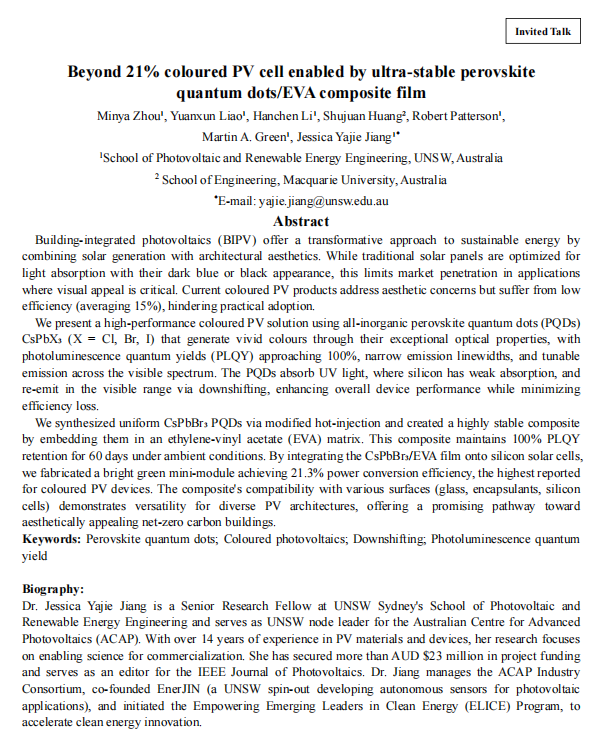| Beyond 21% coloured PV cell enabled by ultra-stable perovskite quantum dots/EVA composite film【Jessica Yajie Jiang】 |
| 发布时间:2025-10-17 | 浏览次数:157 |
Beyond 21% coloured PV cell enabled by ultra-stable perovskite quantum dots/EVA composite film Minya Zhou¹, Yuanxun Liao¹, Hanchen Li¹, Shujuan Huang², Robert Patterson¹, Martin A. Green¹, Jessica Yajie Jiang¹* 1School of Photovoltaic and Renewable Energy Engineering, UNSW, Australia 2 School of Engineering, Macquarie University, Australia *E-mail: yajie.jiang@unsw.edu.au Abstract Building-integrated photovoltaics (BIPV) offer a transformative approach to sustainable energy by combining solar generation with architectural aesthetics. While traditional solar panels are optimized for light absorption with their dark blue or black appearance, this limits market penetration in applications where visual appeal is critical. Current coloured PV products address aesthetic concerns but suffer from low efficiency (averaging 15%), hindering practical adoption. We present a high-performance coloured PV solution using all-inorganic perovskite quantum dots (PQDs) CsPbX₃ (X = Cl, Br, I) that generate vivid colours through their exceptional optical properties, with photoluminescence quantum yields (PLQY) approaching 100%, narrow emission linewidths, and tunable emission across the visible spectrum. The PQDs absorb UV light, where silicon has weak absorption, and re-emit in the visible range via downshifting, enhancing overall device performance while minimizing efficiency loss. We synthesized uniform CsPbBr₃ PQDs via modified hot-injection and created a highly stable composite by embedding them in an ethylene-vinyl acetate (EVA) matrix. This composite maintains 100% PLQY retention for 60 days under ambient conditions. By integrating the CsPbBr₃/EVA film onto silicon solar cells, we fabricated a bright green mini-module achieving 21.3% power conversion efficiency, the highest reported for coloured PV devices. The composite's compatibility with various surfaces (glass, encapsulants, silicon cells) demonstrates versatility for diverse PV architectures, offering a promising pathway toward aesthetically appealing net-zero carbon buildings. Keywords: Perovskite quantum dots; Coloured photovoltaics; Downshifting; Photoluminescence quantum yield Biography: Dr. Jessica Yajie Jiang is a Senior Research Fellow at UNSW Sydney's School of Photovoltaic and Renewable Energy Engineering and serves as UNSW node leader for the Australian Centre for Advanced Photovoltaics (ACAP). With over 14 years of experience in PV materials and devices, her research focuses on enabling science for commercialization. She has secured more than AUD $23 million in project funding and serves as an editor for the IEEE Journal of Photovoltaics. Dr. Jiang manages the ACAP Industry Consortium, co-founded EnerJIN (a UNSW spin-out developing autonomous sensors for photovoltaic applications), and initiated the Empowering Emerging Leaders in Clean Energy (ELICE) Program, to accelerate clean energy innovation.
|






